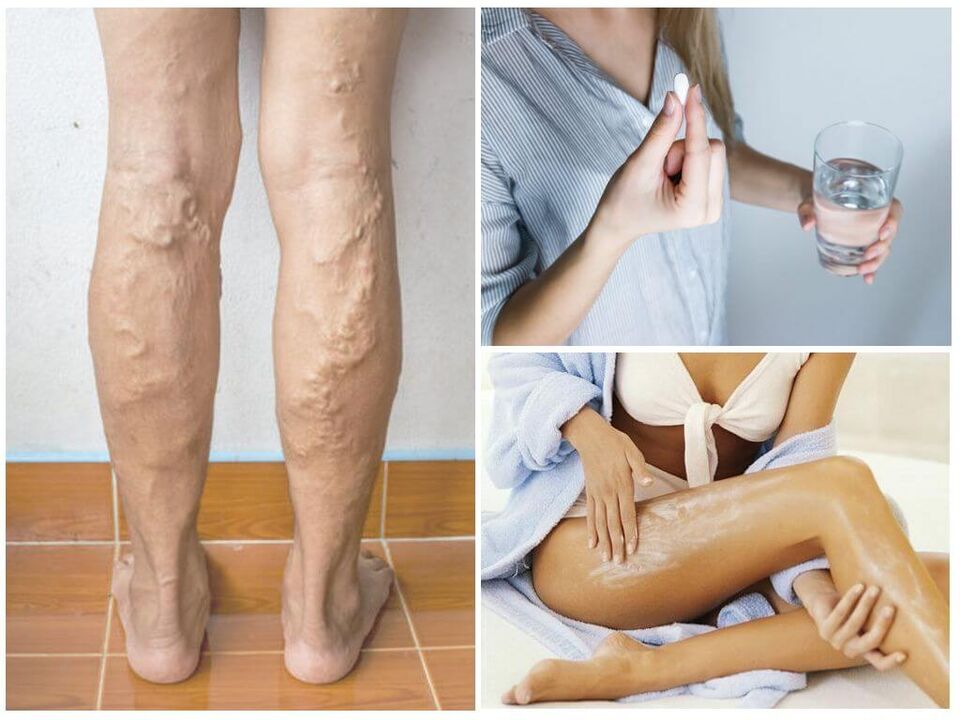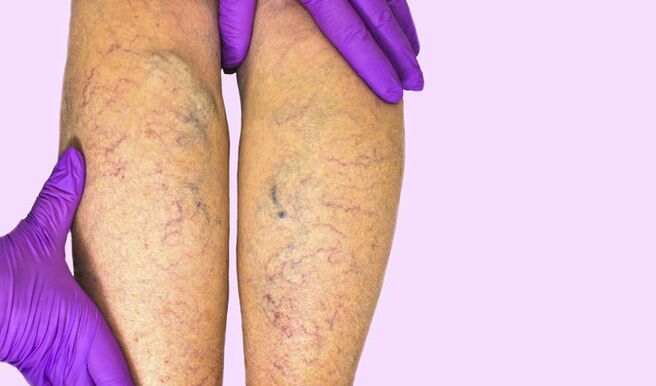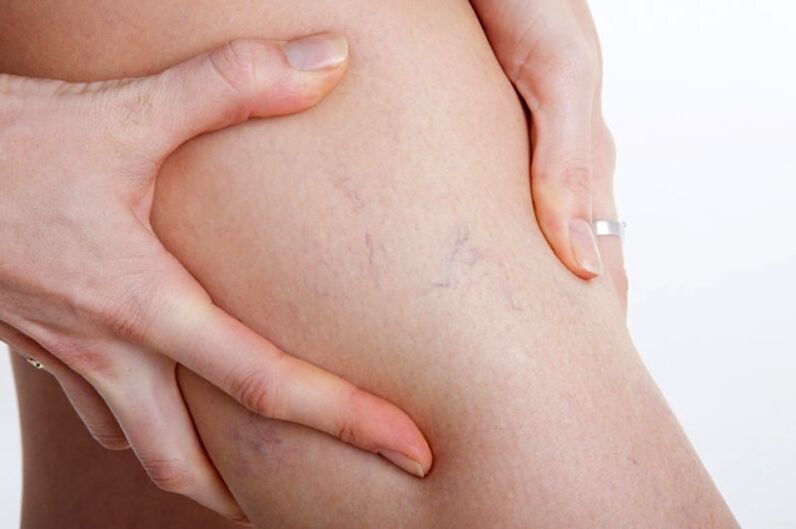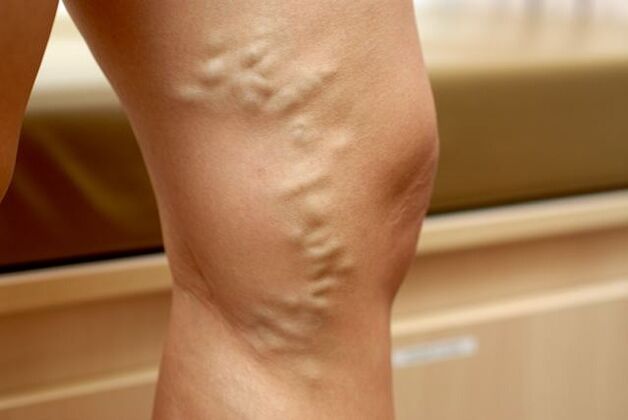
One of the oldest diseases of the vascular system is varicose veins in the legs. The disease develops more often in women. The pathological process is based on the expansion of internal or deep veins, which leads to an inflammatory process of the superficial venous network. As a result, blood flow and tissue nutrition are disturbed, causing the most dangerous complication in the form of trophic ulcers.
Causes of pathology
The disease most often affects the veins of the lower extremities, as it is this part of the body that bears the greatest burden. Signs of varicose veins in women usually appear during pregnancy.There are many reasons that contribute to the development of symptoms of varicose veins in the legs:

- The hereditary predisposition to the development of varicose veins is due to the transfer from the parents to the child of a special gene that undergoes mutation and contributes to the formation of a weak vascular wall.
- Hormonal disorders in the female body during pregnancy, breastfeeding, menopause adversely affect the state of blood vessels, lead to the formation of blood clots and other pathological conditions.
- Severe forms of obesity lead to physical inactivity, circulatory disorders, increased intra-abdominal pressure. As a result, the flow of venous blood is disturbed, which leads to the development of varicose veins. An additional factor is the violation of lipid metabolism and the deposition of harmful cholesterol on the walls of blood vessels.
- Type 1 diabetes mellitus negatively affects the state of the vascular system and eventually leads to complications. The second type is not as dangerous for blood vessels, so it rarely causes varicose veins.
- A sedentary lifestyle, strenuous physical work invariably leads to a violation of venous flow.
- Frequent abuse of alcohol, coffee, strong tea leads to dehydration, especially when combined with the use of a minimal amount of water. As a result, the blood thickens, blood clots form, causing blockage of blood vessels and circulatory disorders.
- An unbalanced diet with an insufficient amount of vitamin C in the diet, which is responsible for the condition of the vessels, their strength.
- Chronic congenital anomalies of the blood characterized by excessive formation of clotting factors and formation of blood clots.
- Wear tight clothing that obstructs venous return.
- Intermittent or chronic constipation. During exertion, intra-abdominal pressure increases, interrupting blood flow.
- Chronic pathologies of the heart, negatively affecting the entire vascular system.
- The use of drugs that increase blood clotting.

Another factor that causes the symptoms of varicose veins in the lower limbs in women is the frequent use of high-heeled shoes. It is proven that men get sick 2 times less.
Symptoms and stages of disease development
Symptoms and treatment of varicose veins of the lower extremities depend on the stage of the pathological process. There are several stages in the development of the disease:

- in the initial phasepathologies in the area of the legs and feet, dark blue or purple spider veins appear. They do not bother the patient and do not protrude above the surface of the skin.
- in the second phaseseveral dilated veins appear, hard and painful to the touch. Nodules are felt in the affected veins.
- third stagecharacterized by the appearance of a large number of deformed veins that protrude above the level of the epidermis.
- in the fourth stagein place of the affected veins, redness of the epidermis or blue spots appear, which begin to itch. The itching is so unbearable that the patient cannot control himself. At the places of scratches, a weeping and painful surface appears.
- In the fifth or sixth stagespots merge, forming ulcers. In the absence of treatment, the process of tissue necrosis begins, reaching the bone in advanced cases.
In the early stages, there may be no pain in legs with varicose veins. Symptoms appear as the pathological process progresses.Common symptoms of the disease include the following:
- Heaviness in the legs at the end of the working day, even with minimal effort.
- Swelling after physical exertion, disappearing after resting in a horizontal position.
- Convulsive contraction of muscles at night.
- Excessive dryness of the epidermis on the shins, itching and burning.
- Increased fatigue.
In addition, the patient begins to be disturbed by constant, arching pains in the limbs. As a result, he avoids physical activity, spends a lot of time sitting. In the advanced stages, when trophic ulcers become necrotic, the patient's movement is very difficult, as the pain becomes unbearable.
Possible complications of varicose veins
The lack of treatment leads to the development of serious consequences of varicose veins. Complications develop in 30% of patients. Common complications are venous bleeding, thrombophlebitis, dermatitis, eczema, which develop as a result of impaired blood supply to tissues.
Most often, trophic ulcers appear, which significantly reduce the patient's quality of life. Incorrect and untimely treatment causes tissue necrosis. In this case, surgical treatment is indicated by excision of the necrotic foci.
Methods for diagnosing a disease
During the diagnosis of the disease, it is very important to determine the cause that caused it. This will make treatment easier.

The first step of the examination will be a test: the patient is placed on the couch, he lifts the leg perpendicular to the body and holds it for 30 seconds to ensure that blood flows out of the veins of the lower extremities. Then, with a special tourniquet, the limb is pulled in the thigh region and the patient is asked to stand up. Normally, blood flow to the limb should last for at least 15 seconds. If this period is shorter, the presence of the initial stage of varicose veins is suspected.
During phlebography, a special contrast agent is injected intravenously into the patient and the permeability of the deep veins is evaluated on an x-ray. To determine the permeability in a specific vessel, Dopplerography is performed.
The most informative method is ultrasonic angiography, which not only allows you to assess the permeability of the dilated vessel, but also to see the degree of its damage.
Based on the data of the diagnostic examination, the doctor draws up a treatment regimen, which is individual in each case.
Principles of conservative therapy
The initial stages of the pathological process are successfully treated conservatively. To eliminate the symptoms of the pathology, tablet preparations and agents for external application in the form of gels and ointments are used.The most prescribed drugs are:
- Pills against varicose veins. They have anti-inflammatory, decongestant, analgesic, tonic properties, stimulate blood circulation, strengthen the vascular wall, eliminate itching, burning, restore the elasticity of vessels. Some of them are in the form of ointments or gels.
- External agents act similarly to tablet preparations. Effective at an early stage of the pathological process. The use of such funds is allowed in the absence of trophic ulcers.
- A mandatory step in the treatment will be to take anticoagulants, for example acetylsalicylic acid, which will help to prevent new blood clots.
- Non-steroidal anti-inflammatory drugs are used to relieve pain in the later stages of the disease.
The early stages of varicose veins are successfully treated with laser photocoagulation. During the procedure, the affected vessels are exposed to a laser that seals them, preventing the pathology from progressing. Most often, manipulation is performed to eliminate a cosmetic defect, as the affected limb looks unattractive.
Surgical intervention methods
Advanced cases of the disease are barely amenable to conservative therapy. When the pathological process has passed to the stage of trophic ulcers, the patient is offered an operation that will radically solve the problem.
Sclerotherapy refers to minimally invasive methods of therapy and consists of eliminating nodules. During manipulation, a special sclerosing agent is injected into the lumen of the vein, which contributes to its gradual death. Prior to introduction, the vessel is removed from the general circulation by ligation and cutting.
Phlebectomy is the complete removal of diseased vessels through small incisions or punctures. It is performed to eliminate extensive lesions.
As a rule, the recovery period is painless. For 2-4 weeks, the patient should wear compression underwear or bandage the diseased limb with an elastic bandage.
Alternative medicine recipes
In the early stages of varicose veins, folk remedies are quite effective. Most doctors approve of combining conservative therapy and nontraditional prescriptions.The following are considered the most effective:
- A compress of chopped green tomatoes will help relieve pain and swelling, normalize blood circulation, which is applied to the affected area and left overnight, secured with a bandage. Many do not understand why green tomatoes, because they have less nutrients. But the secret of this product lies in the high content of lycopene, which eliminates congestion. It is permissible to use ripe fruit in the form of a paste.
- To increase the effect of the drugs, it is recommended to consume freshly squeezed vegetable juices from carrots and beets daily. Especially valuable is the juice of celery leaves, which has an extremely positive effect on blood vessels.
- An effective remedy for pain relief is grated potatoes, which should be applied to the legs, left for 4 hours, washed. Repeat the procedure daily until the patient's condition is relieved.
- Protruding veins can be treated with a special compress of 1 part minced garlic and 2 parts butter. The compress is applied at night for 2 weeks.
- Chestnut-based tincture will help relieve heaviness and pain in the legs. To prepare it, you need to take 200 g of peeled fruits, grind and pour a liter of alcohol, leave for 2 weeks to infuse. Use to scrub every night for 21 days. Take a 10-day break and repeat the course.
- An effective remedy is chamomile oil. It is necessary to prepare it from 150 g of crushed flowers and 500 ml of olive oil. After 10 days of infusion, the composition is ready for use. It is permissible to rub sore limbs or apply compresses at night. Carry out treatment until the condition is relieved.
These funds must be used with a physician's permission. You can avoid allergic manifestations with the help of a preliminary test of individual intolerance to a certain drug.
Disease prevention measures
People prone to developing varicose veins need to take preventive measures. Comfortable shoes and loose clothing that do not obstruct venous flow are recommended. You must adhere to the principles of a healthy diet, go for walks, give up bad habits.
As a preventive measure, it is necessary to periodically take multivitamin preparations that strengthen the vascular wall.
At the first sign of varicose veins, you should immediately contact a specialist to prescribe the necessary treatment. This will help to avoid serious complications.


















